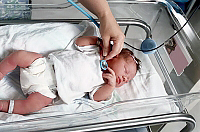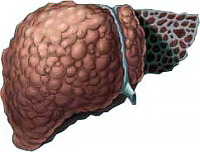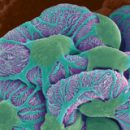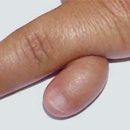Cirrhosis of the liver in children is detected in 20% of cases of all chronic liver diseases. Forms and clinical pattern of liver cirrhosis in children are similar to these manifestations in adults. We are talking about the complications and the course of the disease.
Content
 Chronic progressive disease of the liver in children, as in adults, is characterized by damage to the organ and all its structural elements, diffuse brutalization of the connective tissue and the liver seal. Under the influence of various reasons, the death of healthy hepatic cells occurs, resulting in replacement of hepatocytes with fibrous cloth. Liver — The most important body involved in the digestive process responsible for the removal of toxic waste and the creation of the necessary human substances, in one word, without the liver, the body can simply collapse.
Chronic progressive disease of the liver in children, as in adults, is characterized by damage to the organ and all its structural elements, diffuse brutalization of the connective tissue and the liver seal. Under the influence of various reasons, the death of healthy hepatic cells occurs, resulting in replacement of hepatocytes with fibrous cloth. Liver — The most important body involved in the digestive process responsible for the removal of toxic waste and the creation of the necessary human substances, in one word, without the liver, the body can simply collapse.
Cirrhosis of the liver in children can occur even in newborns, which is associated with viral infections transferred by the mother during pregnancy — serum hepatitis, cytomegaly, herpetic infection, rubella, when the virus is transmitted to the fetus through the placenta, that is, transplascent. If a woman during pregnancy suffered syphilis, toxoplasmosis or lesteriosis in a newborn, a liver damage is noted, sometimes a disease occurs due to congenital gallway infections.
The main symptoms of liver cirrhosis in children
Among the symptoms and signs of the liver cirrhosis in newborns, first of all, it should be noted an increase in liver and spleen, jaundice and light feces. When examining a child, a specialist neonatologist is detected by the presence of bruises and hemorrhagic races on the skin of the face and the body, sometimes bleeding from the residues of the umbilical, noticeably pronounced development of the venous network in the region of the abdominal wall, the presence of biliary pigments is determined in the urine — All these are characteristic signs of liver cirrhosis. Attention should be paid to some difficulties of diagnosis, in such cases, laparoscopy in combination with liver biopsy.
Liver cirrhosis in children — The phenomenon is not frequent, but, unfortunately, sometimes escaping from the professional look of the neonatologist, a timely recognized disease leads to its further development and progression with a disappointing forecast, more often in boys of school age. Some types of liver cirrhosis in children can be congenital against the background of existing family heredity. The wide range of disease is fixed mainly in the countries of Asia and the Middle East, here is often found by the Sen syndrome, and when used from grain, clogged with heliotrope seeds, cases of heliotropic cirrhosis are observed.
Forms and signs of liver cirrosis are the same as in adults, however, mixed variants of cirrhosis are most often dominated. In addition, postnotechnical, portal and biliary form.
Clinical picture of the disease
 The clinical picture of the disease in children is marked with a long latent period with malaise and uncertain lethargy, drowsiness and apatine. There is a noticeable weight loss and loss of appetite, weakness, headache, nausea, frequent temperature increase to subfebrile values, nasal bleeding, dry skin. The child complains of pain in the field of liver, there is a meteorism, diarrhea or constipation. Palpatorno, when inspected, the increase and seal of the liver and spleen is revealed, on the skin of the child are visible plots of depigmentation, star rashes, the skin joins.
The clinical picture of the disease in children is marked with a long latent period with malaise and uncertain lethargy, drowsiness and apatine. There is a noticeable weight loss and loss of appetite, weakness, headache, nausea, frequent temperature increase to subfebrile values, nasal bleeding, dry skin. The child complains of pain in the field of liver, there is a meteorism, diarrhea or constipation. Palpatorno, when inspected, the increase and seal of the liver and spleen is revealed, on the skin of the child are visible plots of depigmentation, star rashes, the skin joins.
The further development of the cirrhosis is noted behind the lag in physical development, exhaustion, hair loss, increased hemorrhagic syndrome, the appearance of signs of portal hypertension, forms varicose veins of the esophagus and stomach, the result of which the sudden profound bleeding and expansion of the venous network on the stomach, a sign called named «Head of Medusa». The final stage of the disease is characterized by the appearance of ascites and general edema. The stages of the disease are also determined as in adults:
- compensated;
- subcompensated with a bright clinical picture;
- Decompensated or terminal with signs of hepatic failure.
The course of children's liver cirrhosis is long with degradation and improvement periods, but the disease usually progresses and the life forecast is very unfavorable and serious, together with cases of erase and latent forms, when the disease may end with recovery.









